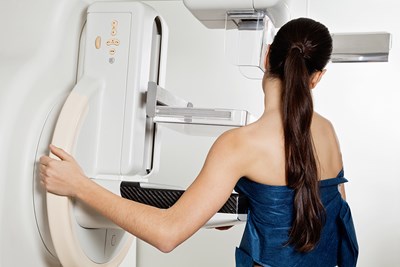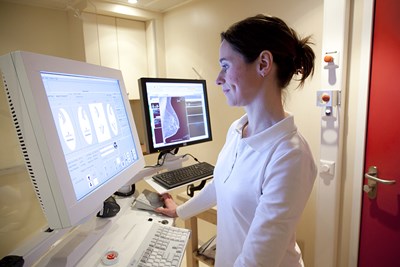Breast cancer is the second most common type of cancer in women in the United States. However, our improvements in screening tests and techniques are making giant leaps in early detection and successful treatment of this disease. The most common screening method for breast cancer is mammography, which uses X-rays to create a detailed image of the breast tissue. These images are analyzed by doctors to look for anything that looks abnormal or irregular, as well as compared to previous images for any changes that may have occurred.
Film mammograms are black and white images that are on large sheets of film. For many years, mammograms were recorded only on film. However, there are now new ways to record mammograms that offer more efficient ways for storing and analyzing the information.
Digital Mammography
Digital mammography allows the mammogram images to be recorded directly into a computer. The advantage to this method is that it allows your doctor to view the image on a computer screen where specific areas can be highlighted and enlarged. If there is a suspicious area, digital mammograms allow your doctor to take a closer look. It is also a lot easier for the information to be transmitted electronically from one location to another.
Many studies have been done to try to determine whether film mammography or digital mammography is more accurate than the other. However, most studies show that both techniques are more or less equally accurate at detecting breast cancer in the early stages. However, one study found that digital mammography was a better tool for women who were under the age of 50, had very dense breast tissue, or were still menstruating or in the early stages of menopause.
One more advantage to digital mammography is that it delivers about three-fourths of the radiation that film mammograms do—however, the amount of radiation delivered by film mammograms is still very little and very safe. The disadvantage of digital mammograms is that they are more expensive and not as widely available as film mammograms.
3D Mammography
Some special imaging machines can take multiple two dimensional digital mammograms in order to create a three dimensional image of the breast tissue. Three dimensional breast images are called breast tomosynthesis. Radiologists must have specialized training in order to be able to read breast tomosynthesis images. Two dimensional mammography is not replaced by breast tomosynthesis; rather, the two methods are usually used in combination.
There are some studies that suggest that breast tomosynthesis used with two dimensional mammography may be able to find a few more breast cancers than two dimensional mammography alone. However, breast tomosynthesis delivers approximately twice the dose of radiation than regular mammograms, though it is still within the FDA’s recommended dosage guidelines. Breast tomosynthesis is a method that is available at some centers, but it is a method that is still under study and not yet considered a standard practice. It is still not clear whether or not combining two dimensional mammography with breast tomosynthesis is a better screening tool than regular mammography alone.



